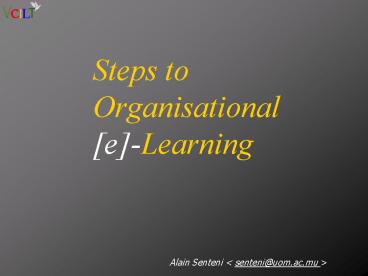Steps to Organisational [e]-Learning - PowerPoint PPT Presentation
1 / 24
Title: Steps to Organisational [e]-Learning
1
Steps to Organisational e-Learning
Alain Senteni lt senteni_at_uom.ac.mu gt
2
individualsteams, groups, communitiesorganisat
ions
It is not the strongest of the species that
survive, nor the most intelligent, but the ones
most responsive to change. Charles Darwin
3
individualsteams, non formal
groupsorganisations
?
Tacit Knowledge
e-learning
Knowledge Emergence
?
?
Knowledge Creation
Value Addition
Explicit Knowledge
?
Knowledge Emergence
Knowledge creation
?
4
Knowledge is no longer what it used to be !
- We need to go from an individualistic vision of
knowledge to an instrument-mediated, socially
distributed one. - The term management implies control of processes
that might be inherently uncontrolable. Beyond
knowledge management, there is a need for
knowledge enabling and knowledge creation - Knowledge involves shared understanding, shared
values and shared belief systems.
- Example In the process of outsourcing (e.g.
BPO) co-configuration becomes a key issue to
avoid being caught into rigid frameworks while an
interaction process evolves.
5
From Linger 2002 Monash (Star Group)
Personal
?
?
Community
?
?
Thru a thingification of processes, an ICT
platform helps tidy up the knowledge space, with
an emphasis on communities
Organisational
6
A unifying platform creates a space in which the
spiraling process of conversion tacit/explicit,
private/public can occur. Th eJapanese call this
space BA
7
Community (Wenger)
- Communities are collections of people that engage
in Knowledge Management activities encompassing a
common interest, and where there is ongoing
learning through shared practice and shared
knowledge - Information and Communications Technologies (ICT)
enable communities that span conventional
boundaries of learning and doing, as well as
space and time. - Online communities must be regarded as complex
socio-technical systems,
8
Dimensions of Community
- What it is about ? joint enterprise as
understood and continually renegotiated by its
members - How it functions? mutual engagement that bind
members together into a social entity - What capacity it produces? A shared repertoire of
resources (routines, sensibilities, artifacts,
vocabulary, styles, etc.), shared knowledge and
shared practice that members develop over time.
9
Attributes of Community
- The key elements of communities are practice
(doing) and identity (belonging) development
(growing). - Communities are fundamentally self-organizing
systems - Communities structure learning in two ways
through the knowledge they develop at their core
and through interactions at their boundaries. - Communities expand through the learning that
people do together - Lifelong learning through work
- Learning by doing, experiential learning
10
Learning and Practice
- In education there is an emerging imperative for
creating learning environments that take
advantage of the dynamic developmental nature of
communities relevant to the ever-changing,
technology-enabled world in which they will live
and be employed. - Similarly, there is a business imperative for
intellectual capital creation, a socially
constructed dynamic process capable of being
leveraged into economic and social value.
11
Innovation and knowledge creation come from
teams, groups and communities of
practice/interest/learning. Working, learning
and innovating are considered complementary.
12
"we say, you do" model of management
- The hierarchical corporation (1950s) operates
through command-and-control. - Commands from the highest-level executives is
translated down through layers of management as
activities for the next level below. - Control takes place by superiors acting as
inspectors, ensuring that results met
specification.
The enterprise as organism
13
When ineffective, Command Control
becomesCommunicate Hope
14
The enterprise as social network acts
purposefully both in its parts and as a whole
- Self-Reliance to act using the resources
available locally - Empowerment to enable subjects to react
immediately to changing circumstances by having
access to decision-making. - Interdependence to obtain resources elsewhere
in order to act, to mutualize human resources - Asynchrony to enable subjects to operate as
quickly as possible, given local circumstances - Reflexivity to enable critical thinking and
creativity - Commitment to regulate social interaction,
reciprocity and collaboration
How about convergence, emergence
consistency ?
15
The Pear Blossom Highway metaphor
Global vs local towards an hypertextual vision
of management and organisation
16
Hypertextual management
- Flat, non hierarchical structure, team-based,
project-oriented. Openness is essential. - Emphasis is put on intensive sharing of Knowledge
and mixed-mode and multi-faceted interactions
among staff (conversations, electronic exchanges,
etc) - The mix of work and learning and how learning
occurs in experiential, team-based,
project-oriented, activity. - Focus is on how trust is developed, how
teambuilding occurs and the contribution of
interaction, in particular face-to-face,
video-conferencing and online. - Examples KAO, SHARP ( Nonaka Takeuchi)
17
Emergence produces a challenge in convergence of
purpose and consistency in response.
Co-reference remains a problem
18
Community as tool-mediated activity system
conceptual models, tools and equipment they use
- the purpose to which members direct their
activity
- the rules, culture and context that govern how
they work, and learn through their work
- individual workers/learners, colleagues and
co-workers/learners
19
Co-configuration interacting activity systems
as minimal model for the third generation of
activity theory
- The third generation of activity theory needs to
develop conceptual tools to understand dialogue,
multiple perspectives and voices, and networks of
interacting activity systems. In this mode of
research, the basic model is expanded to include
minimally two interacting activity systems.
20
Interacting activity systems thru platform-based
transparency and exteriorisation of local
knowledge
Shared platform
21
(No Transcript)
22
Activity at the Virtual Centre for Innovative
Learning Technologies
Pedagogies Developmental Work Visual
Communication Multimedia
Community services ICOOL Online Contents
iLearn platform Learning Object
Repository Educational Multimedia
Web Developers Analyst Programmers Instructi
onal Designers Multimedia Developers Infograp
hists Researchers
23
Case Studies for co-configuration
- The Computer Proficiency programme (CPP), joint
enterprise, co-configuration between
Implementation Working Group (IWG), VCILT and
NPCC. - Using IT for TL of Science in schools,
co-configuration between the Mauritian Research
Council (MRC) and VCILT - Using IT for TL of Science in schools,
co-configuration between the Mauritian Research
Council (MRC) and VCILT - ITES-BPO training, co-configuration between IWG,
IVTB and VCILT.
24
Thank you for your attention































